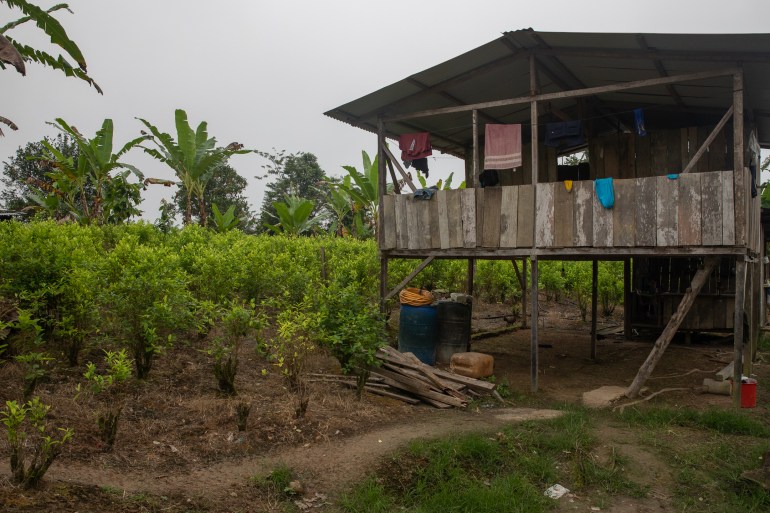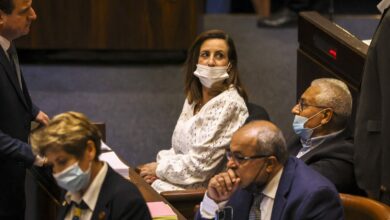Colombia shifts strategy in drug war away from coca eradication | Drugs News

Bogotá, Colombia — After promising to radically change Colombia’s drug policy, government of President Gustavo Petro announced plans this month to reduce forced eradication efforts that, for decades, has remained one of the country’s main strategies to curb coca, the raw ingredient in cocaine.
Growing illegal coca is big business in Colombia. The country is the world’s largest producer of cocaine and the cultivation of coca recently hit a recordwith the United Nations Office on Drugs and Crime (UNODC) estimating that 204,000 hectares (504,095 acres) have been set aside for production by 2021.
In an effort to fight drug trafficking, Colombia has deployed security forces antiseptic and manually remove the coca plant from the ground. But the leftist Petro government has promised to change tactics, away from policies farmers suffer and instead promises to go after the drug traffickers.
On January 10, Colombia’s National Police announced a 60% reduction in eradication targets for 2023, saying it would destroy only 20,000 hectares (49,421 acres) of coca crops. That’s down from last year’s target of 50,000 hectares (123,553 acres), although only 44,000 hectares (108,726 acres) were ultimately wiped out after coca farmers protested.
The government is expected to announce eradication targets for the military, also responsible for coca plant removal, at a later date.
Reduction eradication targets are the latest policy change in the administration’s ongoing effort to improve The decades-long war on drugsa US-led campaign that Petro, a former rebel fighter, has been criticized. Instead, his administration announced plans to offer economic alternatives to coca farmers.
“We will supply oxygen to certain activities and suffocate others: oxygen to the weakest links in the chain, to coca farmers, and asphyxiation to traffickers, for the money launderers and the mafia,” Justice Minister Nestor Osuna said in December.
But as the Petro tests a new anti-drug strategy, the president will face pressure, both domestically and internationally, to reel in the expanding coca industry.
“The Petro view is completely different,” said Gimena Sánchez-Garzoli, Andes director of the Washington Office for Latin America, a think tank. “But in particular, his views on drugs are seen by the elite in Colombia and by anti-drug fighters in the United States as absolutely disturbing.”
Petro’s predecessor, Former President Ivan Duqueadvocated eradication tactics, believing that targeting the coca plant would reduce violence and weaken armed groups.
He tried unsuccessfully continued aerial fumigation with glyphosate, a strategy that was banned by the government in 2015 when the World Health Organization classified the herbicide as a probable carcinogen.
Duque also extended terrestrial eradication, destroying a record high of 130,000 hectares (321,237 acres) in 2020 through the end of 2020. police and military operations.
“I don’t think there has ever been a greater effort in the drive for forced abolition than during the Duque administration, but I don’t think there has ever been a greater effort to force abolition,” said Maria Alejandra Velez, director of the Center for Drugs and Security Studies at the University of the Andes. it still doesn’t work. . “There is concrete evidence that eradication is not the solution.”
Petro chose a different approach that stems from the idea that Colombia’s drug problem is driven by inequality. He has avoided aerial disinfection and has promised to focus on eradicating the so-called “industrial sector”.
In an interview with Al Jazeera, the Colombian Ministry of Justice described such fields as large coca farms, where there are no houses and crops other than coca. Their scale far exceeds that of a sustainable family farm, known as family farming unit.
“These are not small coca farms,” said Sonia Rodriguez, a spokeswoman for the Department of Justice. “It was in these areas that it was confirmed that we would carry out the eradication.”
Increased coca production remains a common concern for the United States and Colombia. Experts believe that the unprecedented growth in coca farms is due to factors including a increasing global demand for cocaine and changes in Decade-long armed conflict in Colombia.
Another factor is the aggressive implementation of the plan to provide subsidies and economic alternatives to coca farmers who have voluntarily uprooted their crops. The program was originally developed as part of Historic Peace Agreement 2016 middle Revolutionary Armed Forces of Colombia (FARC) — the country’s largest armed group at the time — and the government.
But subsidies to launch long-term businesses failed to materialise, causing a crisis among farmers who could no longer grow coca nor finance a new business venture. . UNODC reports that by 2020, about 100,000 coca-growing families have voluntarily removed their crops.
Petro has committed to delivering on promised subsidies and introduced more families to the program, supplementing the program with investments in agricultural reform, infrastructure and rural development.
Some parts of the program will also be redesigned with input from coca growers. The first meeting of coca growers was convened in December in Norte de Santander, a province on the Venezuelan border with the second largest coca-producing area in the country. An estimated 8,000 people from across the region submitted proposals for the conference.
The government has accepted one of the proposals – allowing coca farmers to continue harvesting until their alternative businesses are economically sustainable. In the past, farmers had to destroy coca plants before receiving subsidies.
“I will talk to officials to create a program where farmers can plant coca as they plant a replacement until that replacement is operational. If it worked, there would be no need for the other,” Petro told a stadium crowded with farmers in December.
But farmers are also calling for an end to all forced eradication that they say has devastated their livelihoods, displaced families, increased deforestation and sparked violent confrontations. between farmers and security forces.
Responding to the police’s new eradication target, Juan Carlos Quintero, leader of the Catatumbo Farmers’ Association, said any attempt to forcibly remove crops “creates violence and distrust”. He added that the use of force should be seen as a last resort.
The US State Department has also objected to the reduction of eradication targets but for different reasons. In a statement, it said that “it is fundamental to take advantage of all available tools to reduce coca planting,” including forcibly removing the crop.
Petro had to cross a thin line between appeasing Washington and keeping his promise to Colombia’s drug policy reform. America is Colombia’s Most Important Ally and the biggest sponsor for Colombian Peace Agreement.
Garzoli-Sánchez, an adviser to Andes at the Washington Office on Latin America, pointed out that Petro’s policies appear to align with Washington’s priorities, at least on paper.
The management of US President Joe Biden offered a “Comprehensive approach to disrupt the drug trade, focus on rural development, security, and implement the 2016 peace deal. Still, Garzoli-Sánchez said, however, there are divisions within the U.S. State Department and Congress supports the use of military force.
“That’s the problem [Biden’s] Garzoli-Sánchez said Colombia policy is still not a mainstay in Washington among anti-drugs.

University of the Andes Professor Velez said the diversion from crop removal means the success of Petro’s anti-drug efforts now depends on other measures, of which there are few details.
In October, President Petro said Colombia and the United States were working together to disrupt the drug trade by air and sea, and strengthen their intelligence capabilities.
But the Petro’s success will also depend on consolidating agreements with coca growers to ban the expansion of their crops, Velez said.
Quintero, president of the farmers’ union, said he believes an agreement can be reached, one that will empower local leaders to oversee farms with government support and international community.
“It doesn’t have to be the military because there’s no faith in the military,” Quintero said. “Who does this better than the agricultural organizations that wield power in their communities?”





